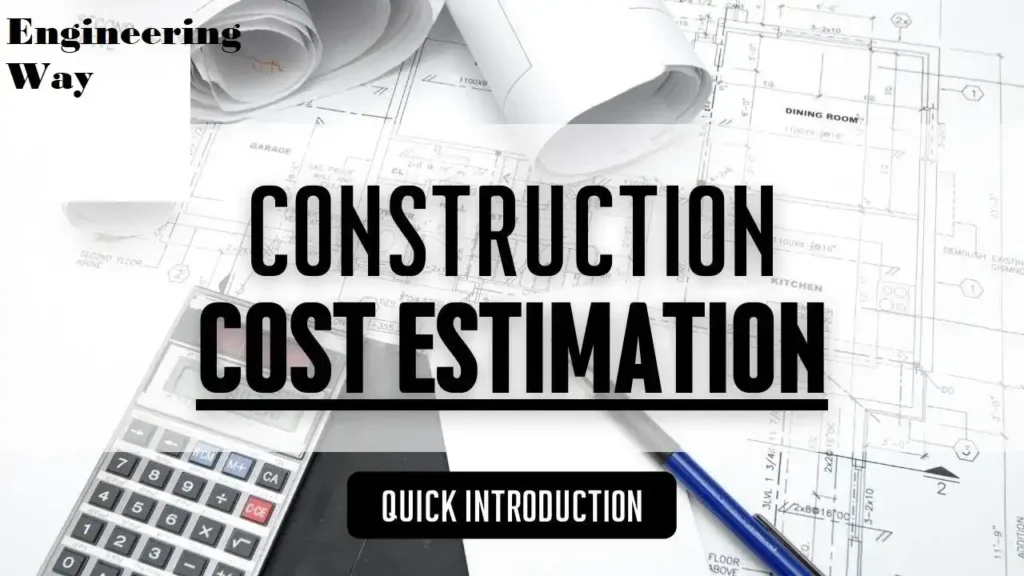Cost estimates must be true in every way so that the works can be used to construct a budget and to prepare bids. The effect of the project proposals of project owners turns into their judgment of whether the ideas are practical and how much money they might need to build them out.
A construction estimate may be little more than rough numbers or the collective product of painstaking detailing and preparation, but each will serve its purpose from early planning to establishing agreements under final terms. This blog will enlighten the different construction estimates, methods of estimating them, and the costs they include.
Types of Construction Estimates

Rough Estimates (Order of Magnitude): These are much earlier-stage estimates deployed in a project when there isn’t much information yet. These give a ballpark figure of costs, usually using past projects as a reference, and accuracy can vary by 20-30%.
Preliminary Estimates: Such estimates are much closer to reality than rough estimates, incorporating design features and material types into them. They assist with getting much more realistic budgets but are still flexible to accommodate change.
Detailed Estimates: Valuing all aspects of the project, materials, and equipment, and the same would happen to value materials, such as unit estimations. It’s for bids and contracts and has high accuracy and transparency
Unit Cost Estimates: The project is further divided into units (for instance, per square foot or room) under this type, where all unit costs are estimated separately. That makes their adjustments easier if there are changes in project detail.
Bid Estimates: prepared for the bidding process are very precise and include all specifications of the project which serve as the final proposal for submission to clients.
Top Construction Estimation Methods
Various construction estimation methods are used as per the specific needs of a project at particular stages of development. Here are some of the methods most commonly and efficiently used:
1. Unit Price Estimation
Unit price estimation involves dividing tasks or parts for a project and assigning a unit value to each. It’s particularly useful for performing repetitive or similar activities like roads and multi-unit buildings. Historical data, standard rates, and current market conditions can be used to compute budgetary estimates, with sufficient flexibility for changes in scope and/or quantity.
2. Detailed Estimate
Also called bottom-up estimating, it is about calculating the costs for each element of a project, such as labor, materials, and equipment. It is dependent greatly on documentation and is highly accurate; it is suitable for large projects where a complex detail may be involved. It gives a great degree of accuracy in budgeting and further granularity in resource allocation through the various requirements.
3. Analogous Estimating
It involves estimating new projects by comparing them with prior projects of a similar kind. It is most applicable to the early stages of a project for which little information is available. Not as accurate as detailed estimates, but gives a relatively quick and fair assessment of the costs involved.
4. Parametric Estimating
Parametric estimating is the way that cost is predicated upon statistical relationships and parameters such as area or unit counts. By analyzing data from previous projects, this method can give an efficient and accurate outcome for projects with well-defined parameters.
5. Three-Point Estimating
This involves producing three estimates, optimistic, pessimistic, and most likely. The average of these is taken to cater for variability and risks. Particularly applicable for uncertain projects, this approach gives a better-rounded and realistic cost estimate.
What Are the Components of Construction Estimates?
Costs associated with construction estimates are wholly disaggregated on a cost-item basis and include the following areas:
- Labor Costs
Labor costs include all direct financial costs related to wages, salaries, and benefits accrued for project-related personal resources engaged on-site, in supervision, or in project management. These may vary according to the complexity of each job, its location, or even time duration. - Material Costs
Materials can be defined as important construction elements such as concrete, steel, wood, insulation, and finishes. The measurement needs to be accurate to avoid shortages as well as excess material, both of which would cost the project extra. - Equipment Costs
Equipment costs include the rental or purchase of machinery such as excavators and cranes and the tools for each project. They also include consumables, fuel for equipment, and means of transporting equipment to and from the site. - Subcontractor Costs
The subcontracted costs incur when specialized firms or trades are engaged in the activity performed, such as plumbing and electrical work. This will cover labor, equipment, and material incurred for the subcontractor. - Other Costs
Other expenditures include those incurred in permits, insurance, bonding, and overhead administrative costs, subject to compliance with requirements and contingencies for unknown changes in the project scope.
Where are Estimators’ Mainstream Cost Data from?
- Historical Data
Estimators will evaluate the costs of similar actions or materials based on data matched from previous projects. Examples of data include labor rates and prices of materials and equipment usage. Historical records help quickly and accurately estimate. - Supplier Quotes
The latest price for materials and equipment can be accessed directly by contacting suppliers. This provides the estimate with current market rates important for competitive quotations. - Cost Databases
Online and software-enabled cost databases like RSMeans and National Construction Estimator offer data on prices that are comprehensive and standardized. Such kinds of tools make sense, especially in setting cost trends in the industry. - Market Research
They look into market behavior like inflation and geographical price differences to adjust costs relative to supply versus demand. - Subcontractor Bids
It includes tenders from subcontractors, which occur primarily in specialized work. These tenders indicate labor, material, and equipment costs for very specific portions of a project. - Professional Associations and Reports
Cost data, benchmarks, and analysis are provided through cost data from industry associations and publications. Thus, they will be aware of pricing trends and best practices.
Conclusion
Construction estimating methods fall into different types, which can ensure that the project is under budget. Each estimating unit price, detailed estimates, and analogous estimates has its strengths and advantages. The best method to use will depend on the size and complexity of the project and the phase in which it currently is. Accurate estimate is the key to cost control and satisfying the client.
Using proper estimation techniques, on the other hand, certainly avoids misleading scenarios and surprises in construction. Each method gives really useful insights-from historical data to a detailed breakdown of every item. Realizing a clear-cut definition and application of these techniques will help in better planning and managing project costing.
FAQs
Q: What is the highest level of accuracy achievable by construction estimates?
Most precise are detailed estimates. All components of the project are considered and given a full breakdown of all costs for proper financial planning.
Q: How are preliminary estimates different from detailed estimates?
Preliminary estimates are very early or draft cost evaluations. Detailed estimates, on the other hand, are typically more comprehensive, based on finalized plans, and given specific requirements.
Q: What is the value of unit price estimation?
Unit price estimation is very flexible. Possibilities for easily altered adjustments with changes in quantity or scope make this type of estimate perfect for the kinds of projects that have repeat units.
Q: Why is historical data important in construction estimating?
It provides a basis for estimating future costs by presenting patterns from earlier projects, which correlates to more accurate and reliable estimates.


